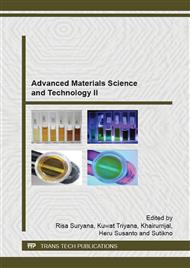p.360
p.364
p.368
p.373
p.378
p.383
p.387
p.391
p.397
Shellac Coated Hydroxyapatite (HA) Scaffold for Increasing Compression Strength
Abstract:
This work reports on the effect of shellac coated hydroxyapatite (HA) on the compression strength. The HA was processed from bovine bone. Shellac was derived from the resinous secretion of the lac insect. The aims of the addition of shellac solution is to improve the mechanical properties of the material, especially when this material is implanted as a bone filler in order to not easily broken.The four different of shellac solutions (2,5%; 5%; 7,5%; and 10% weight) coated HA scaffold and one ratio as a control. It was found that the compression strength is influenced by the shellac solution. The greater of shellac solution will increase the compression strength of HA. The highest compression strength was obtained in a solution of 10%.The morphology of HA scaffold was analyzed by Scanning Electronic Microscopy (SEM).
Info:
Periodical:
Pages:
378-382
Citation:
Online since:
August 2015
Keywords:
Price:
Сopyright:
© 2015 Trans Tech Publications Ltd. All Rights Reserved
Share:
Citation:


